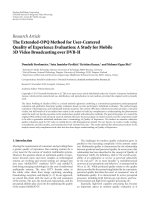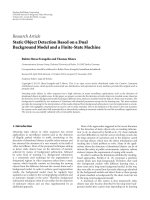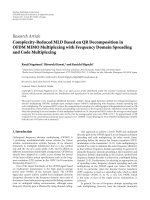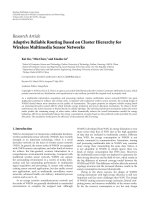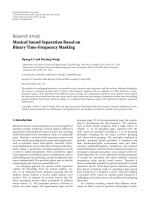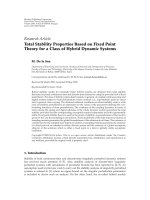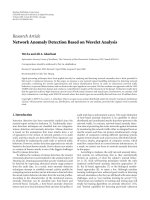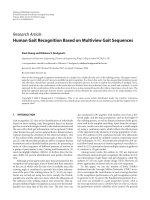Báo cáo hóa học: " Research Article Mobile Broadcast DRM Based on User Identity Card" potx
Bạn đang xem bản rút gọn của tài liệu. Xem và tải ngay bản đầy đủ của tài liệu tại đây (581.22 KB, 7 trang )
Hindawi Publishing Corporation
EURASIP Journal on Wireless Communications and Networking
Volume 2007, Article ID 56050, 7 pages
doi:10.1155/2007/56050
Research Article
Mobile Broadcast DRM Based on User Identity Card
Byung-Rae Lee
Telecommunication R&D Center, Samsung Electronics, Suwon-si, Gyenggi-do 443-742, South Korea
Received 10 December 2006; Revised 22 July 2007; Accepted 12 August 2007
Recommended by Kameswara Rao Namuduri
The current mobile broadcast systems do not provide efficient solution for consumption of service and content based on the user
identity card such as a smartcard. This prevents users from consuming broadcast service and contents independent of a specific
terminal (e.g., the one used for registration or purchase). To provide usage of broadcast services based on the user identity card,
mutual authentication needs to be established among the service provider, the terminal, and the user identity card whenever
the terminal is changed. The crucial element for this is assuring the service provider, the terminal, and the user identity card by
authenticating each entity to the other entities. In this paper, we propose the new authentication scheme, which provides efficient
scheme for three kinds of mutual authentications among the service provider, the terminal, and the user identity card. We also
construct mobile broadcast DRM system based on the proposed authentication scheme for consumption of broadcast services
with multiple terminals.
Copyright © 2007 Byung-Rae Lee. This is an open access article distributed under the Creative Commons Attribution License,
which permits unrestricted use, distribution, and reproduction in any medium, provided the original work is properly cited.
1. INTRODUCTION
Digital rights management (DRM) is widely recognized as
an important tool for managing contents around wireless or
wired network. Recently, DRM has extended its area to mo-
bile broadcast systems such as DVB-H [1]andopenmo-
bile alliance (OMA) BCAST [2, 3]. DRM profile in OMA
BCAST [2]extendedOMADRMv2.0[4]forbroadcastser-
vice environment. Smartcard profile in OMA BCAST [2]ex-
tends multimedia broadcast multicast service (MBMS) [5, 6]
and broadcast and multicast services (BCMCS) [7, 8]with
generic bootstrapping architecture (GBA) [9] for service and
content protection in broadcast environment.
The current mobile broadcast DRM systems do not pro-
vide efficient solution for rights portability with the user
identity card (UIC). Rights portability means consuming
broadcast service using the UIC (i.e., independent of specific
terminals). This prevents users from consuming broadcast
service and contents independent of a specific terminal (e.g.,
the one used for registration or purchase). For example, the
DRM profile [2] and 18Crypt [1] are mainly based on au-
thentication between the terminal and the service provider.
Even though the smartcard profile [2]usesuniversalsub-
scriber identity module (USIM) [10] or removable user iden-
tity module (R-UIM) [11], but it does not provide efficient
mechanism for rights portability in mobile broadcast ser-
vices.
The rights portability with the UIC can be implemented
by rendering broadcast services with multiple terminals us-
ing the user identity card storing rights. Whenever a new
terminal is used for consumption of broadcast services, se-
curity associations need to be established among the service
provider, the terminal, and the UIC. The UIC usually inter-
acts with a terminal for sensitive data exchanged between the
two. Therefore, the need to establish a secure channel be-
tween the UIC and the terminal has been identified in or-
der to protect the communication between them. We list the
following requirements for rights portability with the UIC:
(1) mutual authentication between the terminal and the
UIC;
(2) mutual authentication between the terminal and the
service provider;
(3) mutual authentication between the UIC and the ser-
vice provider;
(4) secure channel establishment between the terminal
and the UIC.
Previous authentication protocols [12–14] and DRM
systems using the user identity [15, 16] do not satisfy
above security requirements for mobile broadcast systems.
The smartcard profile [2] provides rights portability using
(U)SIM or (R-)UIM, however, it suffers from inefficiency due
to execution of different authentication protocols and lots of
2 EURASIP Journal on Wireless Communications and Networking
SP
Terminal
UIC
GBA
U
LT K M
STKM
Encrypted services
Secure authenticated channel
HTTPS
Figure 1: Function flow of the smartcard profile.
message exchanges from GBA U[9], HTTPS [17], and se-
cure channel establishment [18] as shown in Section 2.
In this paper, we propose the new authentication scheme
which satisfies the above requirement. We also present the
mobile broadcast DRM based on the proposed authentica-
tion scheme for rights portability. The proposed authenti-
cation scheme provides efficient way for mutual authentica-
tions among the SP, the terminal, and the UIC.
This paper is organized as follows. We provide brief look
at the prior mobile broadcast DRM system in Section 2.The
overview of the proposed scheme is shown in Section 3.We
propose the new authentication scheme satisfying the above
requirements in Section 4. We utilize the proposed authenti-
cation protocol for mobile broadcast DRM based on the UIC
in Section 5. We provide security analysis of the proposed
scheme and comparison with the previous work in Section 6.
Concluding remarks are shown in Section 7.
2. PREVIOUS WORK
The smartcard profile [2] provides service and content pro-
tection method in the mobile broadcast system. It uses the
(U)SIM [10]or(R-)UIM[11] to receive and store the rights
for rendering protected service for rights portability, that
is, consuming the protected service using various terminals
with the UIC. Figure 1 shows the high level function flow of
the smartcard profile [3].
As illustrated in Figure 1, the smartcard profile [3] uses
GBA
U[9] for mutual authentication between the terminal
and the UIC. HTTPS [17] is run between the service provider
(SP) and the terminal for mutual authentication. The secure
authenticated channel (SAC) is established between the ter-
minal and the smartcard by [18].
The service encryption key (SEK) or the program en-
cryption key (PEK) is packaged in a special long-term key
message (LTKM) format. Pay-per-view customers are pro-
vided with a PEK that is only valid for a single program while
subscribers would be provided with a SEK, valid for recep-
tion of the service for some longer period.
The traffic encryption key (TEK) is applied to the ac-
tual content following different mechanisms depending on
the actual encryption method used. The TEKs are themselves
sent encrypted by a SEK or a PEK. The message carrying en-
crypted TEK is called the short-term key message (STKM).
SP UICTerminal
Authentication of SP
to terminal
Authentication trigger
Authentication request
Authentication of terminal
to SP
Authentication response
Authentication trigger
Authentication request
Authentication of UIM to SP
Authentication response
Authentication of SP to UIC
Figure 2: Overview of the proposed scheme.
The smartcard profile [2] provides rights portability us-
ing (U)SIM or (R-)UIM, however, it suffers from inefficiency
due to execution of different authentication protocols and
lots of message exchanges from GBA
U[9], HTTPS [17], and
secure channel establishment [18]. The proposed scheme
provides enhanced efficiency as shown in Sections 3 and 4.
3. OVERVIEW OF THE PROPOSED SCHEME
In this section, we show overview of the proposed authenti-
cation scheme. The proposed protocol plays a critical role for
a user to consume purchased broadcast contents indepen-
dent of specific terminals (e.g., the one used for purchase)
for rights portability. Unlike the previous work as described
in Section 2, the proposed scheme provides mutual authenti-
cation among the SP, the terminal, and the UIC in one com-
bined protocol. We denote a user identity card as the UIC
and also denote the service provider as the SP in the rest of
this paper.
The overview of the proposed scheme is shown in
Figure 1 and described in the following.
(1) The SP provides authentication trigger message to the
terminal. For example, the authentication trigger mes-
sage can be embedded in the service guide [2].
(2) On receipt of the message in step (1), the terminal for-
wards the trigger message to the UIC.
(3) On receipt of the message in step (2), the UIC gener-
ates digital signature using a random number from the
SP. The UIC delivers the digital signature and its own
identity to the terminal. This message represents au-
thentication of the UIC to the SP.
(4) On receipt of the message in step (3), the terminal also
generates digital signature and delivers the digital sig-
nature and its identity to the SP. This message repre-
sents authentication of the terminal to the SP.
(5) On receipt of the message in step (4), the SP receives
digital signatures from the terminal and the UIC and
verifies them. If the verification is successful, the SP
generates its digital signature and authentication result
of the terminal and the UIC, respectively. The SP sends
the message to the terminal. This message represents
authentication of the SP to the terminal.
(6) On receipt of the message in step (5), the terminal re-
ceives the authentication result of the UIC and verifies
Byung-Rae Lee 3
SP UICTerminal
Authentication trigger
ID
SPRND1TS1
Authentication request
ID
SPRND1TS1ID UMAC1(ID SPRND1
TS1ID U)ID TMAC2(ID SPRND1TS1
ID T)
Authentication response
Proof
UProof TTS2E(KT, KUT)MAC3(E(KT,
KUT)
Proof UTS2)E(KU, KUSKUT)
MAC4(E(KU, KUSKUT)Proof TTS2)
Authentication trigger
ID
SPRND1TS1
Authentication request
ID
SPRND1TS1ID UMAC1(ID SP
RND1TS1ID U)
Authentication response
Proof
UProof TTS2MAC3(E(KT, KUT)
Proof UTS2)E(KU, KUSKUT)MAC4(E(KU,
KUSKUT)Proof TTS2)
Figure 3: Proposed authentication protocol based on symmetric key cryptosystem.
digital signature from the SP. The terminal also for-
wards the message to the UIC. This message represents
authentication of the SP to the UIC.
(7) On receipt of the message in step (6), the UIC receives
the message from the terminal and verifies the authen-
tication result of the terminal. If the verification is suc-
cessful, then the UIC allows communication with the
terminal.
4. PROPOSED AUTHENTICATION PROTOCOLS
This section shows the proposed authentication protocols for
mutual authentications among the SP, the terminal, and the
UIC and secure channel establishment between the termi-
nal and the UIC. We show the proposed protocol based on
both symmetric key cryptosystem in Section 4.1 and public
key cryptosystem in Section 4.2.
4.1. Authentication protocol based on
symmetric key cryptosystem
The following protocol in Figure 3 shows the proposed au-
thentication with symmetric key-based system. In the pro-
tocol, we assume that the UIC shares a symmetric key, KU,
with the SP for encryption and generation of message au-
thentication code. We also assume that the terminal and the
SP shares asymmetric key, KT, for encryption and generation
of message authentication code. We described the following
protocol independent of specific encryption and message au-
thentication algorithms.
In the following, we provide description of the proposed
authentication protocol which works based on symmetric
key cryptosystem. We assume that there is a shared key, KU,
between the SP and the UIC and also assume that there is a
shared key, KT, between the SP and the terminal before the
protocol starts.
(1) The SP sends authentication trigger message which
consists of identity of SP ID
SP, random number
RND1, and time stamp, TS1.
(2) On receipt of the message in step (1), the terminal for-
ward authentication trigger message to the UIC.
(3) On receipt of the message in step (2), the UIC adds
its identity ID
U and generates message authentication
code MAC1 on this message using the symmetric key
shared with the SP before the protocol starts. The UIC
forwards this message to the terminal
(4) On receipt of the message in step (3), the terminal
adds its own identity ID
T and generates message au-
thentication code MAC2 on ID
SP, RND1, TS1 and
ID
T. Terminal directly forwards authentication re-
quest message to the SP.
(5) On receipt of the message in step (4), the SP generates
Proof
UandProof T, containing authentication result
of the UIC and terminal, respectively, based on the
verification result of MAC1 and MAC2. The SP gen-
erates the time-stamp, TS2, and generates encryption
of KUT, a session key between the UIC and terminal,
and KUS, a new shared key between the smartcard and
SP, using KU. The SP also generates the encryption of
KUT using KT. The SP generates the message authen-
tication code, MAC3, on E(K
T, KUT), Proof U, and
TS2 for the terminal to verify it. The SP also generates
the message authentication code, MAC4, on E(KU,
KUS
KUT), Proof T, and TS2 for the UIC to verify
it. The SP sends this message to the terminal.
(6) On receipt of the message in step (5), the terminal
verifies MAC3 and can be assured that whether in-
tegrity of the message is correct or not. After verifica-
tion of Proof
U, the terminal can find out that whether
the UIC can be trusted or not. The terminal decrypts
E(KT, KUT) using KT and verifies MAC2. Finally, the
terminal forwards the message to the UIC.
4 EURASIP Journal on Wireless Communications and Networking
(7) On receipt of the message in step (6), the UIC verifies
MAC4 and can be assured that whether integrity of the
message is correct or not. After verification of Proof
T,
the UIC can find out that whether the terminal can
be trusted or not. The UIC acquires KUS and KUT by
decryption of E(KU, KUS
KUT) using KU.
After the successful run of the above protocol, the UIC
and the terminal establish a common secret key the KUT. The
UIC also acquires a new session key between the SP and itself.
For efficiency, the terminal may not forward some elements
related to itself to the UIC in the last message.
4.2. Authentication protocol based on
public key cryptosystem
The following protocol in Figure 4 shows the proposed au-
thentication protocol based on the public key cryptosystem.
Unlike the previous protocol, we assume that the terminal
and the SP has public key and private key for encryption and
digital signature operations such as RSA [19]. We also as-
sume that the UIC shares a symmetric key with the SP for
encryption and digital signature operations. We described
the following protocol independent of specific public key en-
cryption and digital signatures mechanisms.
In the following, we provide description of the proposed
authentication protocol which works based on public key
cryptosystem. We assume that there is a public and private
key pair for the terminal and the SP, respectively, and also as-
sume that there is a shared key KU between the SP and the
UIC before the protocol starts.
(1) The SP sends authentication trigger message which
consists of identity of SP ID
SP, random number
RND1, and time stamp, TS1.
(2) On receipt of the message in step (1), the terminal for-
ward authentication trigger message to the UIC.
(3) On receipt of the message in step (2), the UIC adds
its identity ID
U and generates message authentication
code MAC1 on this message using the symmetric key
shared with the SP before the protocol starts. The UIC
forwards this message to the terminal.
(4) On receipt of the message in step (3), the terminal adds
its own identity ID
T and generates the digital signa-
ture on ID
SP, RND1, TS1, and ID T using its private
key. The terminal directly forwards authentication re-
quest message to the SP.
(5) On receipt of the message in step (4), the SP generates
Proof
UandProof T, containing authentication result
of the UIC and the terminal, respectively, based on the
verification result of MAC1 and Sign
T. The SP gener-
ates the time-stamp, TS2, and generates encryption of
KUT, a session key between the UIC and terminal, and
KUS, a new shared key between the UIC and SP, using
KU. The SP also generates the encryption of KUT us-
ing PK
T which is the public key of the terminal. The
SP generates the digital signature, Sign
SP, on encryp-
tion of KUT E(PK
T, KUT), Proof U, and TS2 for the
terminal to verify it. The SP also generates the message
authentication code, MAC2, on E(KU, KUS
KUT),
Proof
T and time-stamp from the SP, TS2, for the UIC
to verify it. The SP sends this message to the terminal.
(6) On receipt of the message in step (5), the terminal
verifies Sign
SP and can be assured that whether in-
tegrity of the message is correct or not. After verifica-
tion of Proof
U, the terminal can find out that whether
the Smartcard can be trusted or not. The terminal de-
crypts E(PK
T, KUT) using its private key. After that,
the terminal forwards the message to the UIC.
(7) On receipt of the message in step (6), the UIC verifies
MAC2 and can be assured that whether integrity of the
message is correct or not. After verification of Proof
T,
the UIC can find out that whether the terminal can
be trusted or not. The UIC acquires KUS and KUT by
decryption of E(KU, KUS
KUT) using KU.
After the successful run of the above protocol, the UIC
and the terminal establish a common secret key the KUT. The
UIC also acquires a new session key between the SP and itself.
For efficiency, the terminal may not forward some elements
related to itself to the UIC in the last message.
5. MOBILE BROADCAST DRM WITH THE PROPOSED
AUTHENTICATION PROTOCOL
In this section, we show how the proposed authentication
protocol can be used for rights portability in the mobile
broadcast system. The mobile broadcast DRM system with
the proposed authentication scheme shown in Section 4 con-
sists of two phases. The terminal executes the proposed au-
thentication protocol during registration procedure in the
first phase. When the UIC is in contact with a new termi-
nal, it runs the proposed authentication protocol for mutual
authentication with the terminal and SP in the second phase.
5.1. Mobile broadcast system with the proposed
authentication scheme
This section shows the overall flow for mobile broadcast
DRM system with the proposed authentication protocol.
This following procedure is run when a user subscribes a
new service to acquire the SEK. The procedure is shown in
Figure 5 and described in the following.
(1) The UIC runs the proposed authentication protocol
with the SP. The proposed protocol can be run in part
of the registration procedure.
(2) The terminal transfers service request containing iden-
tity of the UIC, ID
U, Service ID, and a random num-
ber, RND1, to the SP for acquisition of SEK.
(3) The terminal receives service response message from
the SP and forwards it to the UIC. The UIC stores the
RO in secure memory area. The RO contains SEK or
PEK.
(4) The UIC acquires the rights object from the SP, ex-
tracts SEK from the RO, and stores SEK in secure
memory area in the UIC.
(5) The SP broadcasts traffic key message in encrypted
form. The UIC receives the message and extracts the
Byung-Rae Lee 5
SP UICTerminal
Authentication trigger
ID
SPRND1TS1
Authentication request
ID
SPRND1TS1ID UMAC1(ID SPRND1
TS1ID U)ID TSign T(ID SPRND1TS1
ID T)
Authentication response
Proof
UProof TTS2E(KU, KUSKUT)
MAC2(E(KU, KUSKUT)Proof TTS2)E(PK T,
KUT)Sign SP(E(PK T, KUT)Proof UTS2)
Authentication trigger
ID
SPRND1TS1
Authentication request
ID
SPRND1TS1ID UMAC1(ID SP
RND1TS1ID U)
Authentication response
Proof
UProof TTS2E(KU, KUSKUT)
MAC2(E(KU, KUSKUT)Proof TTS2)E(PK T,
KUT)
Sign SP(E(PK T, KUT )Proof UTS2)
Figure 4: Proposed authentication protocol based on public key cryptosystem.
SP Terminal UIC
ID
UService IDRND1
ID
UE(KU, Rights Object)
STKM
Protected service
Proposed authentication protocol
Service request
Service response
E(KTU, TEK)
Figure 5: Mobile broadcast system with the proposed authentica-
tion scheme.
SP Terminal UIC
Proposed authentication protocol
Tr affic key message
Protected service
E(KTU, TK)
Figure 6: The terminal change and the proposed authentication
scheme.
TK. The UIC forwards the TK in secure channel estab-
lished by KUT.
(6) The terminal can decrypt the encrypted TK by KUT
and use TK for decryption of protected services and
contents.
The UIC stores KU and KUT in secure memory area for
further use in the next step shown in Section 5.2.
5.2. Terminal change and the proposed
authentication scheme
When the UIC is in contact with a new terminal, the UIC and
the terminal executes the proposed authentication protocol
with the SP to establish security association.
(1) The terminal and the UIC runs the proposed authen-
tication protocol with the SP. A new secure channel is
established between the terminal and the UIC.
(2) The SP broadcasts a traffic key message to the terminal.
The terminal forwards it to the UIC.
(3) The UIC extracts TK from the message and forwards it
to the terminal in secure channel.
(4) The terminal can acquire TK by KTU. The terminal
can decrypt the protected service using TK.
After the successful authentication of the terminal and
the UIC by the SP, the SP provides KTU to the terminal and
the UIC for establishment of the secure channel. The termi-
nal and the UIC also authenticate each other through the ex-
ecution of the above protocol.
6. ANALYSIS
6.1. Security
The proposed mobile broadcast DRM system, shown in
Section 5, provides terminal independent use of broadcast
services with the UIC based on the proposed authentication
scheme. Unlike the previous work, mutual authentications
among the SP, the terminal and the UIC are satisfied through
the terminal. In the following, we show analysis of important
properties of the proposed authentication scheme. These re-
quirements are shown in Section 1.
6 EURASIP Journal on Wireless Communications and Networking
Table 1: Comparison with previous works.
GBA UHTTPSSACProposedscheme
Mutual authentication between the terminal and the UIC No No Yes Yes
Mutual authentication between the UIC the SP Yes No No Yes
Mutual authentication between the terminal and the SP No Yes No Yes
Secure channel between the terminal and the UIC No No Yes Yes
Number of messages 4 10 9 6
Mutual authentication between the UIC and the terminal
Proof
UandProofT generated by the SP contains the au-
thentication result of the UIC and the terminal. The terminal
can authenticate the UIC by verifying the Proof
U and the SP
can authenticate the terminal by verifying the Proof
T in the
proposed authentication protocol.
Mutual authentication between the UIC and the SP
The SP can authenticate the UIC by verifying MAC1 in the
authentication protocol. MAC1 contains a random number
from the SP. The UIC can also authenticate the SP by ver-
ifying MAC4 or Sign
SP from the SP in the authentication
protocol.
Mutual authentication between the terminal and the SP
The SP can authenticate the terminal by verifying MAC2 or
Sign
T in the authentication protocol. MAC2 contains a ran-
dom number from the SP. The terminal can also authenticate
the SP by verifying MAC3 or Sign
SP from the SP in the au-
thentication protocol.
Secure channel between the terminal and the UIC
This property can be achieved by the secure channel repre-
sented by the key KTU shared between the terminal and the
UIC.
6.2. Comparison
Ta bl e 1 shows comparison between the proposed scheme and
the previous works for mutual authentication among the SP,
the terminal, and the UIC. The previous work, as shown in
Section 2,suffers from the use of multiple authentication and
key establishment mechanisms such as GBA
U, HTTPS, and
SAC. The proposed protocol achieves all properties of previ-
ousprotocolsinoneprotocolwithenhancedefficiency.
7. CONCLUDING REMARKS
In this paper, we proposed the new authentication scheme
providing mutual authentications among the SP, the terminal
and the UIC. The secure channel between the terminal, and
the UIC is also established as part of the proposed scheme.
Thepreviouswork,asshowninSection 2,suffers from the
use of multiple authentication and key establishment mech-
anisms such as GBA
U, HTTPS, and SAC, but the proposed
protocol achieves all properties of previous protocols in one
protocol with enhanced efficiency. We utilized the proposed
protocol for rights portability based on the UIC in the mobile
broadcast system. The proposed mobile broadcast system al-
lows a user to consume broadcast services and contents inde-
pendent of specific terminals (e.g., the one used for registra-
tion or purchase) with enhanced efficiency.
REFERENCES
[1] IP Datacast over DVB-H: Service Purchase and Protection
(SPP), DVB, 2006.
[2] OMA BCAST v1.0 enabler, Open Mobile Alliance, http://www
.openmobilealliance.org/.
[3] Service Content Protection Specification, Open Mobile Al-
liance, />[4] OMA-DRM-V2
0 enabler, “Open Mobile Alliance
TM
,” http://
www.openmobilealliance.org/.
[5] 3GPP TS 26.346, “Multimedia broadcast/multicast service
(MBMS); protocols and codecs,” 3rd Generation Partner-
ship Project, Technical Specification 3GPP TS 26.346, http://
www.3gpp.org/.
[6] 3GPP TS 33.246, “Security of multimedia broadcast/multicast
service,” 3rd Generation Partnership Project, Technical Speci-
fication 3GPP TS 33.246, />[7] 3GPP2 X.S0022, “Broadcast and multicast service in
cdma2000 wireless IP network,” 3rd Generation Partner-
ship Project 2, Technical Specification 3GPP2 X.S0022, http://
www.3gpp2.org/.
[8] 3GPP2 S.S0083, “BCMSC security framework,” 3rd Gener-
ation Partnership Project 2, Technical Specification 3GPP2
S.S0083, />[9] 3GPP TS 33.220, “Generic authentication architecture, generic
bootstrapping architecture,” 3rd Generation Partnership
Project, Technical Specification 3GPP TS 33.220, http://www
.3gpp.org/.
[10] 3GPP TS 31.102, “Characteristics of the universal subscriber
identity module (USIM) application,” 3rd Generation Part-
nership Project, Technical Specification 3GPP TS 31.102,
http:// www.3gpp.org/.
[11] 3GPP2 C.S0023, “Removable user identity module for
spread spectrum systems,” 3rd Generation Partner-
ship Project 2, Technical Specification 3GPP2 C.S0023,
/>[12] W. Diffie and M. Hellman, “New directions in cryptography,”
IEEE Transactions on Information Theory,vol.22,no.6,pp.
644–654, 1976.
[13] T. Elgamal, “A public key cryptosystem and a signature scheme
based on discrete logarithms,” IEEE Transactions on Informa-
tion Theory, vol. 31, no. 4, pp. 469–472, 1985.
[14] S.P.Miller,B.C.Neuman,J.I.Schiller,andJ.H.Saltzer,“Sec-
tion E.2.1: Kerberos authentication and authorization system,”
Byung-Rae Lee 7
Tech. Rep., M.I.T. Project Athena, Cambridge, Mass, USA, De-
cember 1987.
[15] C. Conrado, F. Kamperman, G. J. Schrijen, and W. Jonker,
“Privacy in an identity-based DRM system,” in Proceedings of
the 14th International Workshop on Database and Expert Sys-
tems Applications (DEXA ’03), pp. 389–395, Prague, Czech Re-
public, September 2003.
[16] T. Kalker, M. Spasojevic, A. Said, A. Petruszka, P. Shah, and P.
Mclean, “A case for person-centric digital rights management,”
in Proceedings of the IEEE Consumer Communications & Net-
working Conference, (Workshop on Digital Rights Management
Impact on Consumer Communications) (CCNC ’05),LasVegas,
Nev, USA, January 2005.
[17] E. Rescorla, “HTTP over TLS,” RFC 2818, f
.org/rfc/rfc2818.txt.
[18] 3GPP TS 33.110, “Key establishment between a UICC and
a terminal,” 3rd Generation Partnership Project, Technical
Specification 3GPP TS 33.110, />[19] R. L. Rivest, A. Shamir, and L. Adleman, “A method for obtain-
ing digital signatures and public-key cryptosystems,” Commu-
nications of the ACM, vol. 21, no. 2, pp. 120–126, 1978.
